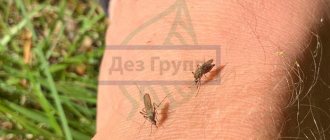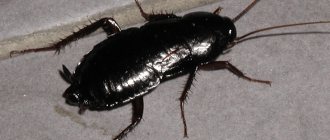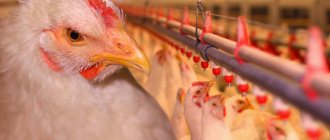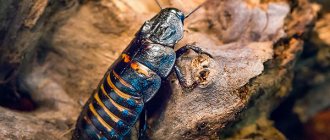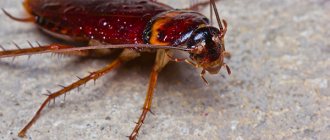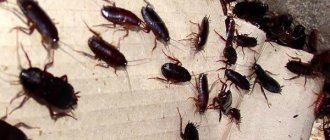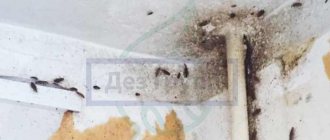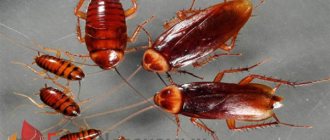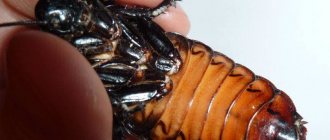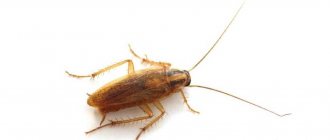337
The Turkmen cockroach, also known as Turkmenistan, Central Asian, or in Latin Shelfordella tartara, is very popular among owners of exotic animals. This type of insect is bred not as decoration, but as food. Hedgehogs, opossums, spiders, praying mantises, chameleons, ants and other insectivorous fauna are happy to eat Turkmen cockroaches. They are distinguished by their weak defense ability, delicate chitinous cover and the absence of an unpleasant odor, which makes them an attractive food source. Breeders like the unpretentiousness of cockroaches, rapid reproduction and inability to move on vertical surfaces.
Description
The adult is about 3 cm long. Adult males are brownish-orange or red in color, slender, with long yellowish wings, with the help of which they attract females and can glide. Adult females are dark brown to black, with cream markings on the carapace and a cream stripe along the edges of the wings; they are wider than males and have short vestigial wings. Nymphs are brown in front, black behind and wingless.
Male - light, female - dark
Turkmen cockroaches and people
Breeding Turkmen cockroaches.
The Turkmen species of cockroach is considered safe for humans. It does not bite, the oral apparatus is not so developed as to bite through human skin. The insect is not poisonous and has a calm disposition.
Even if a cockroach or several individuals escape, they do not reproduce at home and do not become natural pests.
However, those who suffer from asthma or are allergic should be careful. Excrement and residues are an allergen; those suffering from diseases of the respiratory system should better refrain from breeding or working with this species.
Habitat
It is primarily an "outdoor" insect and is not known to be an aggressive household pest like cockroaches such as the red cockroach and furniture cockroach, although it is found in areas around residential buildings where shelter can be found. However, in certain areas or in the tropics, it can become a serious household pest. Males are more likely to become random house intruders than females due to their ability to fly and their attraction to light. In Arabia, it lives under rocks in damp cavities, desert farms and wadis, feeding mainly at night.
Nymphs
Why are they dangerous for people?
There have been no recorded cases of human bites by Turkmen cockroaches. There is still controversy over the fact that individuals that escaped from the insectarium can breed in the apartment and compete with the Prussians. Theoretically, red runners could create a colony in a person’s house, but in reality, such settlements have not been observed.
Turkmen cockroaches pose a danger to people prone to allergic reactions. Insect excrement is a strong allergen that can trigger an attack of bronchial asthma.
Area
The species is found in Central Asia, the Caucasus and northeastern Africa. Can be found throughout Afghanistan, Azerbaijan, Egypt, India, Iran, Iraq, Israel, Jordan, Kashmir, Libya, Palestine, Pakistan, Saudi Arabia, Sudan, United Arab Emirates and the United States (as an adventive species).
Adult female
Reviews from breeders
Alina, 41 years old, Moscow My husband and I gave our son a whole farm - with hundreds of individuals in a special insectarium. He is interested in insects, so he decided to start by breeding easier-to-care pets.
Anna, 37 years old, Samara I raise cockroaches, although I don’t like them very much. But the child's pet needs something to eat - he has an iguana. Among other food sources, we provide insects. They crawl quickly, although I read that they should move slowly.
Sergey, 38 years old, Yaroslavl There were different cockroaches, but the Argentine ones live the longest. They are easy to care for. I have trays in my insectarium (there is no other substrate), I quickly change them, no problems with insects have arisen.
The Argentine cockroach is a frequent visitor to insect breeders.
Introduction to the USA
The Turkestan cockroach was first spotted in the United States in 1978 near the former Sharpe Army Depot in California, and soon after appeared at Fort Bliss in Texas and several other military bases. Researchers believe the species arrived on military vehicles returning from Central Asia, possibly Afghanistan. Since then, this species has rapidly replaced the black cockroach (Blatta orientalis) in urban areas of the southwestern United States "as the most important peri-house species" because it surpasses it in the number of eggs laid and the rate of development. A 2013 study found that at 26.7°C, male and female nymphs matured into adults in an average of 222 and 224 days, respectively. They typically live in underground containers such as water meters, irrigation and electrical boxes, voids in concrete, cracks and crevices, and hollow block walls.” They are well known in the southwest and parts of the southeast, and have also been recorded in the northeast.
Adult males
Lifestyle
Like other subspecies, Madagascar cockroaches are extremely shy. During the day they try to hide somewhere, and at night they crawl out of their hiding places, trying to find food for themselves. In their usual habitat, insects live in fallen trees and old stumps.
The Madagascar cockroach is an attractive treat for most birds and wildlife. The insect, as soon as it feels threatened, immediately stops, presses itself to the ground and merges with the surface. But even if a predator tries to grab a cockroach, it is not so easy to do: the chitinous shell is very slippery, and its paws are extremely tenacious.
If the situation develops according to the worst scenario, then the insect begins to hiss heart-rendingly, emitting sharp and unpleasant sounds for a good half of the attackers. Actually, it was for this feature that it received its second name.
Looking at the human perception of sound, it can be compared to the hiss of a snake. Many animals are afraid of the latter, so this protection works well. The sound itself is produced by small spiracles located on the front of the abdomen. The insect sharply reduces them and produces a hissing sound.
In addition to protecting themselves from predators, cockroaches use this remarkable feature when fighting for a mate. The insects collide with their horns and, circling in circles, hiss at each other. If one of the participants is no longer able to continue the fight, then he turns over on his back, admitting defeat. When the winner leaves, the loser immediately gets up on his paws and runs away.
As a food item
Turkmen cockroaches are often kept to feed reptiles and other insectivorous animals. Their advantages:
- do not climb on smooth surfaces,
- do not bury themselves in the ground,
- quite easily and quickly divorced,
- do not eat the shell of invertebrates during molting.
Cockroaches are replacing crickets, which for decades were the most popular food insect because they are noisy, smelly, have a short lifespan and are more expensive to keep. Turkmen cockroaches have become a popular species and can easily be purchased online, which may, however, speed up their spread to new habitats, although this is more true for regions such as Crimea than for Moscow or Kaluga.
Subadult male
Although there is little reliable information on the specific nutritional requirements of insectivores, it can be argued that Turkmen cockroaches provide a high protein, low fat diet and are more similar to crickets than to mealworm or zofobas larvae. The contents of a cockroach's intestine, depending on its diet, can provide essential nutrients that are missing in a cockroach with an empty intestine.
Subadult females
In a study of commercially ordered specimens, small second instar nymphs (0.9–1.3 cm) contained 21% dry matter, consisting of 76% crude protein and 14% crude fat, while medium third instar nymphs (1.3–1.3 cm) 1.9 cm) contained 28% dry matter, consisting of 53% crude protein and 27% crude fat. Mineral content is well represented, with the exception of the low calcium to phosphorus ratio found in cockroaches and calcium supplementation may be required. The content of vitamins A and E was relatively low and tended to be significantly higher in free-ranging cockroaches. Insectivores that feed on unsupplemented invertebrates have been found to suffer from vitamin A deficiency, and studies of panther chameleons (Furcifer pardalis) have shown that vitamin A deficiency shortens lifespan and reduces reproductive rates.
Turkmen cockroaches are rich in vitamin B12.
Ootheca
Arrangement of the insectarium
Most breeders store and raise feeder cockroaches in special small clear plastic tubs that can be purchased at most hardware stores. Although you can choose any sizes; It is preferable to use 1 meter by 0.5 meters and about 30 cm in depth.
Advice: before purchasing; check that they are smooth - some have textured sides that can be used by cockroaches to climb on.
You can fill the storage container with soil - this is soil about a centimeter deep. You can throw a few pieces of decontaminated tree bark as cover so they can hide.
Observe temperature conditions. This is an important factor for the comfortable life of your food cockroaches. The warmer they are, the faster they grow and reproduce. They are kept in a warm room, but can be kept on a warm surface or electrically heated boards.
Tip: If you notice that your young Turkmen cockroaches are dying, it is probably because they are not getting enough moisture to which they are accustomed in the wild and their chitinous covering is drying out.
Feeding tartar in captivity
Keeping them at home requires compliance with a number of rules. It is advisable to arrange a “dry” corner in the insectarium, in which you can put dry food for aquarium fish, cats and dogs (loose or in the form of small granules), oatmeal, dried young oak leaves, finely chopped dandelion greens. Although cockroaches, as a rule, take food to secluded closed places to eat.
You can give them fresh fruits and vegetables a couple of times a week (usually from bits of what you ate for lunch, carrot peels, apple seeds.
Thanks to such taste preferences, growing Turkmen cockroaches does not require large financial expenditures.
Taratra never eats its relatives, and the skins remain after molting. This may cause mites in the cage or an allergic reaction. Therefore, the insectarium should be cleaned regularly.
It is not recommended to give cockroaches bananas, cabbage and tomatoes. Eating them worsens the taste of the insect, which is unfavorable when growing it for food.
Advice:
Put fresh fruits or vegetables in the mold will develop, it will not attach to the side of the bathtub, providing a manual escape route for cockroaches.
You must choose the optimal menu for your pets yourself. Avoid placing food scraps that attract fruit flies.
When removing old food, check to make sure there are no baby cockroaches or eggs left behind before disposing.
Colony expansion
There are three developmental stages of the red cockroach; egg, nymph and adult. However, Turkmen cockroaches have a shorter development period compared to Oriental cockroaches, and their females also produce significantly more eggs than Oriental cockroaches.
Each female and her offspring can produce about 200 cockroaches in one year. Development from a newly emerged nymph to an adult can take anywhere from a year to two years or more.
In many places, the Turkmen population was able to displace competitors due to its biological characteristics.
Parasites
In Iraq, Turkmen cockroaches were found to host larvae of the parasitoid wasp Ampulex assimilis. An adult wasp stings a cockroach, pulls or leads it by its antenna towards a wasp nest, lays an egg on the cockroach's middle leg thigh, then covers the nest with debris. After hatching, the wasp larva feeds externally and then enters the cockroach for further feeding and pupation.
The wasp leads the cockroach into the nest by the antenna. The photo shows an emerald cockroach wasp (Ampulex compressa) from the same genus as described in the article
Breeding Turkmen cockroaches
Turkmen cockroaches are a very nutritious food. But they do not have much calcium and vitamin A. The advantages of breeding include:
- unpretentious care;
- rapid reproduction and growth;
- absence of sounds produced;
- inability to move on a vertical plane;
- the inability to eat the shell of invertebrates during the molting period.
To breed pests you need:
- keep cockroaches in a glass aquarium or plastic container;
- drill small holes in the lid to ensure air circulation;
- Place substrate on the bottom. This could be coconut shells, sawdust, tree bark;
- install a drinking bowl, at the bottom of which there should be foam rubber or cotton wool;
- maintain temperature conditions from 27 to 30 degrees;
- Avoid high humidity.
Often, in addition to the Turkmen species, the Madagascar and marbled cockroaches are also bred.
Reproduction
Before mating, males organize peculiar tournaments. They actively run after each other, trying to drive away the opponent. A special dance is performed for the female with raising her wings. Wing flapping not only looks impressive, it is necessary for the spread of pheromones. Females are viviparous, the number of offspring reaches 20-30. The incubation period lasts about 1 month. In unfavorable climatic conditions or due to hunger, the female throws out the ootheca prematurely. Underdeveloped larvae do not hatch from eggs and die.
The offspring are lighter than the adults, they are beige with a marbled pattern. They are born 2 mm long. The young spend their time buried in the ground. It will take them 4-7 months to reach the adult state.
